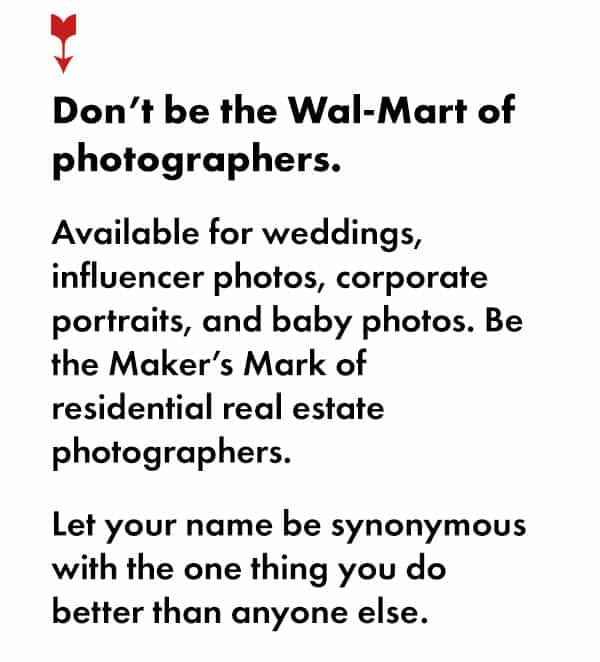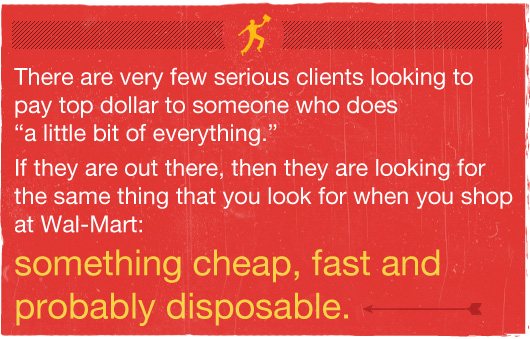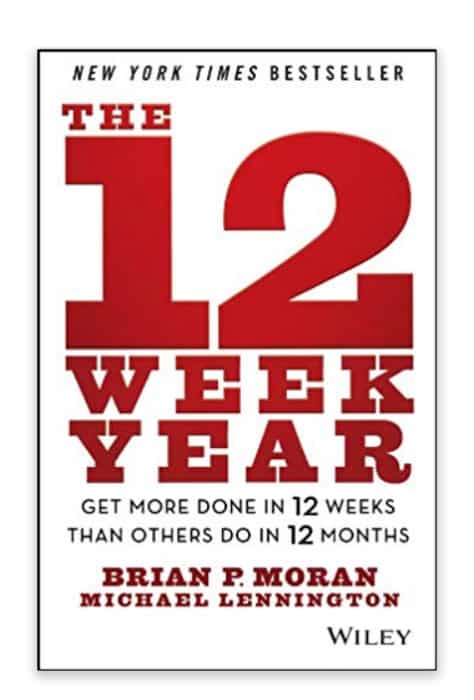Side gigs have a way of cropping up organically. What begins as a hobby or a passion turns out to be something people will pay money for. Without really having a business plan or strategy, you may find yourself working steadily on a handful of contracts, doing something you enjoy that’s not your main job. If you’re in this position, you are incredibly lucky. You have a golden opportunity on your hands to turn your passion into a business.
Your side gig may be viable enough to kill your student loans, pay for a few vacations, or maybe walk away from the 9 to 5 for good. But in order to take your side hustle to the next level, you have to bring something new to the table: focus.
Here are four tried and true ways to apply focus to your freelance or side job.
1. Specialize
You’ve heard this one, and you don’t like it. You are worried that specializing will pigeonhole you, close doors for you, make your work monotonous. You like the fact that you are a jack of all trades, and you believe that being a do-it-all kind of guy means that you’ll cast a bigger net into the market and reel in more fish.
But that’s not how it works.
Being a generalist on the market doesn’t work for two big reasons.
First off, it makes you seem desperate. As someone who has reviewed scores of freelancer resumes, I can tell you that I am not impressed by someone who does “a little bit of everything.” When I see a resume rife with random gigs, it tells me that this person will take any job they can get.
Secondly, these “slutty resumes” signal to me that the applicant isn’t really an expert at any of those things that he does.
Think of it this way:
Whatever it is you do, whether you’re a web designer, a freelance writer, or a political consultant, what you offer isn’t yourself—you offer a product: artful, functional websites; succinct, persuasive prose; or winning campaigns.
And think of how you shop for a product.
When you want a really nice bottle of wine, do you go to a grocery store? When you want a fine cigar, do you stop at 7 Eleven? When you want a killer suit, do you shop at K-Mart?
Of course not. You go to a winery, a cigar shop, or a tailor.
This is the way you need to think about your product. Don’t be the Wal-Mart of photographers. Available for weddings, influencer photos, corporate portraits, and baby photos. Be the Maker’s Mark of residential real estate photographers. Let your name be synonymous with the one thing you do better than anyone else.
In some cases, this might just be a matter of tweaking your marketing. In other cases, it might mean honing your skills in the area that you’ve most found interesting or profitable to date. Either way, if you want to take your side gig to the next level, specializing is a smart growth tactic.
There are very few serious clients looking to pay top dollar to someone who does “a little bit of everything.” If they are out there, then they are looking for the same thing that you look for when you shop at Wal-Mart: something cheap, fast and probably disposable.
The other benefit of specializing is that it narrows your field of competition. If you are a web designer who tries to do everything, then you are practically competing with every web designer hanging a shingle. This includes those who got wise and specialized, as well as all the chumps who are still dabbling here and there like you.
But if you narrow it a bit—let’s say you focus on nonprofits—then you’re only competing against other website designers focusing on nonprofits. You can specialize further by taking a local focus: a website designer serving nonprofits in Dallas. True, your pool of clients will be smaller, but realistically, you only need one or two solid contracts to get rolling. After that, if you’ve done a good job in your field, you’ll start getting referrals and the work will come to you. And once that's happened, you can organically expand to become the go-to in the rest of Texas.
Now read this: Are You T-Shaped? Jack of All Trades, Master of One – And How to Be Both
 2. Charge More
2. Charge More
When you first start venturing into entrepreneurship, it’s easy to get more excited about the work than the pay. And in many cases, that’s fair to your clients. It makes sense to charge low rates (or no rate) while you build your portfolio and gain experience.
But when you’ve had your foot in the door for a few years and you are still charging the same rates as when you started, that’s a problem. At a certain point, you have to stop letting the market set your personal rate and start finding a market for the rate you need (and deserve).
Here’s how to raise your freelancing rates:
Pick a day on the calendar. Make it a month or even further out, depending on how many open contracts or projects you have at the moment. Let your client know that on that date, you’ll be transitioning your business focus. As part of that, you will be raising your rates to $X. Tell them you are more than happy to close out what’s on your plate at the agreed upon rate, but thereafter, they’ll have to place a new contract based on your new terms. Indicate—either explicitly or implicitly—that this is an across-the-board thing, for the sake of strengthening your business in order to produce a higher quality product.
Most of your clients will be appreciative that you gave them ample notice of your changing terms. This will allow them to kick the news around to whomever needs to make the decision to retain you or look for someone else.
After that, your clients do one of the following:
- Pay your full requested rate – Some of your clients will happily subscribe to your higher rate. Over the years, they’ll have come to appreciate your value, and they won’t want to lose you or the relationship you’ve built.
- Pay part of your requested rate – Other clients will come back with a counteroffer. It may be lower than the rate you asked for, but it’ll be higher than what you were charging before.
- Pay you nothing at all – Lastly, some clients will simply end their business relationship with you.
At first glance, this list looks like it’s listed in order, from ideal to acceptable to bad. But in reality, when clients from the third category drop you, whether they do so amicably or bitterly, it’s probably a good thing. Among the freelancers I talked to while gathering input for this piece, almost all of them said that raising their rates was the best thing they ever did, chiefly because it freed them of their “pain in the ass” clients—the ones with narrow budgets, tight deadlines, and high demands.
The fact that these clients choose to terminate the relationship at this point indicates that these were dead end threads. Clients are always promising contractors bigger and better things once their venture takes off, but frankly, you don’t have time for that. I’m not saying that it won’t take off—good businesses take time—but if they are serious about wanting to pay you more, but they just can’t afford it, they’ll be equally as receptive five years from now, when you are both on firmer ground.
If you are accepting a lower rate at the hope of rewards from your clients' future success, that makes you a de facto investor in that business. And that should not be your goal at this stage.
When your cheap or difficult clients drop you, there will be a sizable void in your workload. Fill it with clients at your higher rate or business development activities.
3. Work More
This might seem like an obvious tip, but sometimes it’s so obvious that we never try it. If you are making $10,000 a year right now, but you’d rather be making $20,000 a year, then the solution is simple: work twice as much as you are right now. You might not double your business right away, but if you are already doing all the right things, then doing it more often is the only way to see a bigger return.
That logic may be easy, but pulling it off can be tough. Here’s how I would go about it:
Find Out How Much You’re Working
The first challenge is to figure out how much you are actually working. If you’re not already, start keeping track. You may be shocked to discover that you haven’t been working nearly as much as you felt like you were. This is actually good news, because it means adding one hour a day could double your weekly productivity.
Toggl, Freshbooks, or a text file with “.LOG” at the top are easy solutions. Better yet, start keeping working hours—say, from 4AM to 8AM every morning or 8PM to 12AM each night (or both, if you’re insane).
A side benefit of this, for me at least, is that a ticking timer makes me a more honest worker. When I’m on the clock—even if it’s my own clock—I tend to stay focused more and trawl Facebook and Twitter less. So, not only do I work more, I work more efficiently.
Make a Commitment to Add Hours
Set yourself a goal to work X more hours per week or per month. And then map out exactly how you’ll achieve that, whether that’s working one extra day on the weekend or waking up an hour earlier every day.
It’s best if this is regimented, but in the face of real life, it doesn’t have to be. Personally, what I like to do is itemize the amount of time I need to work in a month and make them their own to-dos. If I wanted to add 10 hours to my week, I’d go into Toodledo and create five items that read “work 2 hours” and schedule them for when I hope to have time to knock them out. If I miss a day due to extenuating circumstances, I reschedule the item. If I have 10 hours leftover on the last day of the month well…then it’s going to be a long night.
If you're looking for new, manageable ways to get more work, using sites like Upwork can be a smart resource, especially in the beginning.
Start Making Sacrifices
When you try to add more wrench time to your load, you’ll quickly realize that there often aren’t enough hours in the week. But here’s a secret tip that the established fat cats don’t want you to know: You can always work more by being a shitty friend/boyfriend/parent/fantasy football league organizer.
I’m being mostly facetious here—you don’t have to go all out James Taylor on your friends and family. But the stark reality is that personal sacrifice is an essential ingredient to success. If you really, really want to make it, you have to start giving up the things you love. If you’re not willing to do that, then that’s fine, too. But keep those things knowing that you made a conscious choice: you’d rather go to happy hour on Thursday, take a trip with your girlfriend, organize a charity golf tournament or start a band than see your side gig take off.
Keep Busy
Inevitably, you’ll come to a point where you’ll have hours meted out for the week, but nothing to do. Don’t waste that time. Work on non-paid work, like marketing, blogging, pro bono work, following up* with prospects, boning up on your skills with online classes, or otherwise developing your business in a focused way. Have a productive go-to task that directly benefits your business that you can work on whenever you have downtime. If nothing else, it’ll keep you in the habit of working your quota.
(* To reiterate: Following up is one of the best things you can do during your down time. People are busy, forgetful, distracted or whatever. Sometimes pinging someone just to check in to see if they need anything can lead to a project. I’ve seen it work many a time, both as a contractor and a client. If you really want to get serious, set yourself reminders to correspond with your contacts once every four weeks or so, even if it’s just to say “Hi” and ask them what’s new. Just make sure it’s not obvious that your popping in because you’re bored and idle.)
4. Tap into Local and National Small Business Resources
Starting or doubling down on your one-person shop can feel like flying solo. But you are not alone. No matter where you live, there are real live human beings you can get in touch with who can help you start your business or take it to the next level. Often, they’ll do this for free.
Here’s where I’d start:
- Ivy – Organizations like Ivy, that offer learning events, networking, and workshops, are perfect for meeting and learning from a younger set of people than the other more traditional businesses listed blow.
- SCORE – SCORE is a nationwide nonprofit that pairs volunteers with entrepreneurial hopefuls for one-on-one counseling. These volunteers are usually successful executives and managers who can guide you through the thorny challenges of getting started, including developing a business plan, marketing, finance and legal issues and growing your business. The best part of SCORE is that you can usually find someone local who can meet you in person, and potentially introduce you to other important local contacts and resources. Check out SCORE.org for their mentoring, local workshops and free online workshops.
- Chamber of Commerce – A chamber of commerce is a local or state organization that exists to further business interests in the region. Similar to SCORE, the big benefit of a chamber of commerce is that they can offer local perspectives and people in your area who can help. Most chambers of commerce require a membership fee, but there are often a number of perks, such as networking opportunities and free workshops. Being a member of the chamber also gives you a stamp of legitimacy from a trusted organization in your community. I recommend searching for your local chamber of commerce (e.g. the one specific to your town or county) and then trying for a state level chamber of commerce.
- SBA – The U.S. Small Business Administration is a federal organization that has online resources as well as a few different channels for local assistance. For example, check out their guide for Self Employed & Independent Contractors. They also have a network of local organizations and partnerships, including Small Business Development Centers, which are partnerships with local colleges/universities that provide “no cost, extensive, one-on-one, long-term professional business advising, low-cost training and other specialized service.” Start by searching for Local Assistance via SBA.gov.
It’s certainly worth getting in touch with one or all of the above organizations. The counseling is often free, and simply talking it out with a business pro can help you gain perspective and focus.
Meeting with a SCORE counselor or going to an SBA workshop might be the last thing you want to try from this list. But it should probably be the first thing. Tapping into these resources and talking to real people lets you map out the exact steps you need to be taking to grow your business. Once you have that, all you have to do is follow instructions.
Essential Entrepreneurship and Business Books to Read Now
The 12 Week Year: Get More Done in 12 Weeks than Others Do in 12 Months
Many people set year long goals, but for some, this can be such a long time period that it becomes too abstract to be actionable. The 12 Week Year helps you focus on tight, specific goals for the next 90 days.
 The ONE Thing: The Surprisingly Simple Truth Behind Extraordinary Results
The ONE Thing: The Surprisingly Simple Truth Behind Extraordinary Results
The successful founder of Keller William Reality strips out all the nonsense and encourages you to zoom in on the Focusing Questions: What is the one thing I can do, such that by doing it, everything else will be easier or unnecessary? This is an audiobook Primer editor & founder Andrew Snavely returns to again and again.
Conclusion
If starting a side gig is like falling a love, then developing it into a bona fide business is like being married. When you first meet someone you are enamored with, all you do is follow your heart. You talk on the phone for hours, stay in bed all day and think about each other 24/7 for the sheer pleasure and novelty of it. Those heady days of new love culminate to the decision that you want to spend the rest of your lives together. And that takes work that goes far beyond burning midnight oil. It requires sound structure, honest introspection, long term plans and unflagging dedication, especially in the face of challenge and frustration.
It can be exhausting, but the fruits of your labor are even more rewarding than those initial pangs of passion.
Likewise, getting serious about your side gig can be daunting. Failure is always a possibility. But if you never apply yourself and go for the gold, you’ll never know what you are capable of.




 2. Charge More
2. Charge More














